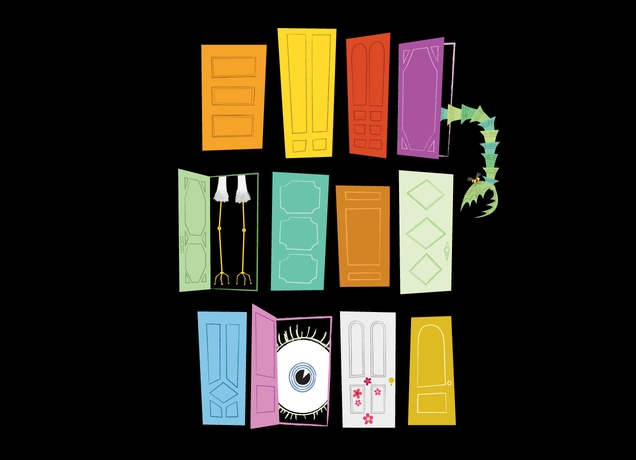Sound Journey Idea
One of my ideas refers back to the first year of Experimental Sound, where we were shown a film (The Double Life of Veronique) in which the protagonist starts listening to audio of someone's journey. We hear distinct noises (such as footsteps, creaking of doors, dialogue, background noise, etc) which create a narrative, distinguishing key moments of the person's journey.
http://www.imdb.com/title/tt0101765/
My idea would be similar to this, featuring a journey through sound. The installation will require the audience to place headphones in and listen to the sounds that are being played back to them, using their imagination to map out a path of their journey. This would place some sort of interactive feature within the installation, which allows each audience member a unique experience and hopefully immersing them into this fictional world.
The inspiration of my work will be solely from Disney Pixar's 'Monsters Inc.', in which I will incorporate a person walking through several different doors featuring different environmental changes/sounds. I will recreate the sounds of these various environments, allowing the audience to differentiate between them and experience what the character is experiencing.
Environments:
Outdoor Grass (Birds tweeting, trees swaying, grass footsteps)
Mountain Climate (Heavy wind, snow footsteps)
Storm (Thunder, Lightning, rainstorm, splashing)
Volcano (Cracking, eruption, audible struggle of the character)
Restaurant setting (Hear background noises of people dining)
Empty room (Echoed footsteps, slight breathing)
Techno room (Odd techno bass sounds, experimenting with techno sounds)
Installation Idea
During the tutorial with Rosie, I discussed the idea and despite interest, I was questioned with how I can present the installation whilst making it interactive to the audience. My original Idea was to present it on a small mp3 player, with headphones attached to it, allowing the audience to immerse themselves in the sound environment. However, after sharing this idea with Rosie, I was told that this idea was less immersive and a slow process for an audience member to have to wait for the person using the mp3 player.
City (Busy streets, crowds, London)
Installation Idea
During the tutorial with Rosie, I discussed the idea and despite interest, I was questioned with how I can present the installation whilst making it interactive to the audience. My original Idea was to present it on a small mp3 player, with headphones attached to it, allowing the audience to immerse themselves in the sound environment. However, after sharing this idea with Rosie, I was told that this idea was less immersive and a slow process for an audience member to have to wait for the person using the mp3 player.
After brainstorming ideas, the plan was to incorporate four doors connected to a small booth. The doors will therefore be used as a switch, triggering the sound of an environment once open. Once a certain door is open, a light representing the sound of the climate will shine into the booth.
The environments were narrowed down to the following:
Volcano (Cracking, eruption, audible struggle of the character)City (Busy streets, crowds, London)
After the presentation to the class, we received feedback on the idea. The biggest criticism with the piece was the fact the the doors seemed to be more of a gimmick, with less of a real meaning behind it. Robert also mentioned the fact that the doors could be used with a sense of curiosity for the audience, which seemed quite interesting to use, as everyone encounters curiosity on their personal journeys.
After a discussion with the group and Rosie, we decided to split up and do our seperate ideas due to time constraints.
Treatment
For the Maps and Journeys installation project, I will incorporate the idea of journeying through an idea, in which it develops in the mind. By presenting it using an illustrated form, I will incorporate sound into the mix in order to allow the audience a more immersive experience.
The concept of this idea will include an illustrated installation piece, much like the works of Hilary White, in which I will layer illustrations over each other to create a 3D piece. In addition, I will specifically place small mp3 players featuring sound, allowing the audience to plug in headphones into sections of the piece in order to hear the part of the journey it will be representing.
The target audience will be aimed at people who generally visit galleries and are interested in interpreting the sound to their own imagination. The basis of the installation will hopefully provide interactivity for the audience in which they will listen to certain points of the journey through headphones.
Equipment/Software needed will include:
Polystyrene
Printer
Scalpel
Spray Glue
Mp3 Players x3
Headphones
Marantz Recorder
Adobe Illustrator/Photoshop
Pro Tools
Sounds needed will include:
Outdoor fields (representing empty thoughts) - Birds tweeting, Trees swaying, light breeze of wind, grass footsteps
Snowy Mountain (representing conflict with ideas) - Heavy wind, snowy footsteps
Volcano (representing the creation of the idea) - Cracking, eruption, steaming noises, bubbling lava
It is important when editing that any copy-written material used during production is used with permission of the holder and is also noted down on the blogs. The sound will mostly be recorded using a Marantz recorder, therefore there won’t be any copyright permission needed.







.jpg)

































